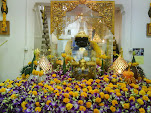The Green Dragon of the East Signifies protection for the home dweller. In Chinese mythology the Dragon is well known and much respected as an emblem for strength, goodness, courage and endurance. The dragon is the protector of the heavens. The White Tiger of the West symbolizes strength. The dragon and the tiger coexist and are inseparable. It is perceived by the Chinese that the Tiger is one of the best symbols of protection against evil intentions from strangers. The Red Phoenix of the South is often depicted as the mate of the Celestial dragon and used in Feng Shui to activate the luck of opportunity. The Black Turtle of the North symbolizes the direction north and winter in Feng Shui. The Turtle is the emblem of longevity, strength and endurance. In Feng Shui the Black Turtle symbolizes a series of hill behind the property.
四神也叫作四象、四灵,即青龙、白虎、朱雀和玄武。青龙白虎掌四方,朱雀玄武顺阴阳。四灵圣兽苍龙、白虎、朱雀、玄武天之四灵虽然欧美奇幻中很少出现,但中国神话传说中它们却以尊贵无比四圣兽身份出现,是古代人民所喜爱吉祥物。四灵导源于远古神话,,起初称为"四象",指水火木金分布四方之象。 《易·系辞上》说:"两仪主四象." 两仪即阴阳或天地。上古表示天空东南西北四大区星象用东龙、南鸟、西虎、北龟蛇(武)四组动物。这四组动物也是中国古代神话中四方之神灵。春秋战国时期由于五行学说盛行,所以四象也被配色成为青龙、白虎、朱雀和玄武。两汉时期四象演化成为道教所信奉神灵故而四象也随即被称为四灵。

 This is a beautiful image of the Buddha from Thailand. This particular style is called "Soumkhor", and it comes from the Khamphaeng Phet area in north Thailand. It is one of the most popular amulets in Thailand. It is believed to bring peace and prosperity to the wearer. This particular image shows the Buddha seated in a meditation position, meditating in the rain under the protection of the Naga, a great 7-headed snake. The story is that the Naga desired to be ordained into the monkhood. The rules forbid it; but the Buddha gave the snake instruction in the 5 Buddhist precepts so that if he followed them, he could be reborn as human in his next life and enter the monkhood. The Naga used his body to form a meditation platform for the Buddha, using his great 7-headed body to form a canopy to shelter Buddha from the rain. The Soumkhor Buddha images are so respected in Thailand that the government recently released a series of postage stamps honoring 5 different Buddha amulets - one of which is Soumkhor.
This is a beautiful image of the Buddha from Thailand. This particular style is called "Soumkhor", and it comes from the Khamphaeng Phet area in north Thailand. It is one of the most popular amulets in Thailand. It is believed to bring peace and prosperity to the wearer. This particular image shows the Buddha seated in a meditation position, meditating in the rain under the protection of the Naga, a great 7-headed snake. The story is that the Naga desired to be ordained into the monkhood. The rules forbid it; but the Buddha gave the snake instruction in the 5 Buddhist precepts so that if he followed them, he could be reborn as human in his next life and enter the monkhood. The Naga used his body to form a meditation platform for the Buddha, using his great 7-headed body to form a canopy to shelter Buddha from the rain. The Soumkhor Buddha images are so respected in Thailand that the government recently released a series of postage stamps honoring 5 different Buddha amulets - one of which is Soumkhor.


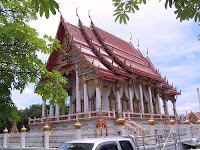




 Sculpture of the Rahu (demon from the Hindu mythology) in the Buddhist-Hindu subject park Sala Kaew Koo (also: Wat Khaek) with Nong Khai, north-east Thailand A unique place with numerous sculptures according to the belief of a sent of Buddhism. Sala Kaew Koo is about 3 km. from Nong Khai on the Nong Khai - Phon Phi - sai road.
Sculpture of the Rahu (demon from the Hindu mythology) in the Buddhist-Hindu subject park Sala Kaew Koo (also: Wat Khaek) with Nong Khai, north-east Thailand A unique place with numerous sculptures according to the belief of a sent of Buddhism. Sala Kaew Koo is about 3 km. from Nong Khai on the Nong Khai - Phon Phi - sai road.
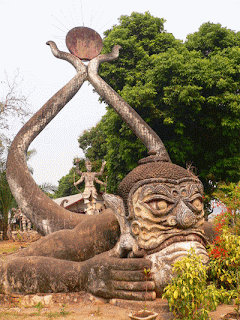




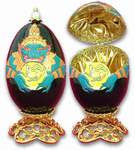









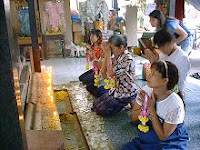
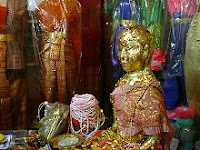
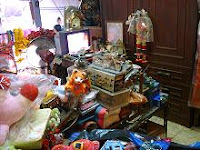



 First of all, I would like to express my thanks to those who have been supporting the blog. Regardless of who you are, where you were from, I’m grateful for all the supports and contributions offered to me during the past few months.
First of all, I would like to express my thanks to those who have been supporting the blog. Regardless of who you are, where you were from, I’m grateful for all the supports and contributions offered to me during the past few months.











